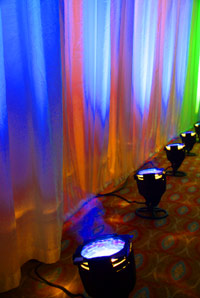Create Exhibits with Curb Appeal
Trade shows are by nature quite chaotic. Attendees bustling from booth to booth while exhibitors fight to garner their attention and interest in their companies’ products or services. Studies have shown that a tradeshow display typically has about three seconds to catch the attention and communicate to a potential customer passing by a booth. To makes things even harder, your booth is competing with possibly hundreds of other displays for attendees’ attention.
 So, exhibitors have a matter of seconds to grab attendees’ and potential prospects’ attention and make an immediate impression. Eye-popping, colorful graphics in tradeshow booths are an excellent way to do just that. Graphics in tradeshow booths can include booth signs, displays, banner stands, and even table cloths. So what makes one booth an attention-grabber and another one that’s easily passed by?
So, exhibitors have a matter of seconds to grab attendees’ and potential prospects’ attention and make an immediate impression. Eye-popping, colorful graphics in tradeshow booths are an excellent way to do just that. Graphics in tradeshow booths can include booth signs, displays, banner stands, and even table cloths. So what makes one booth an attention-grabber and another one that’s easily passed by?
Here are some things to think about when you set about creating the graphics that will hopefully deliver a powerful visual punch and grab the attention of potential prospects.
Pick a good color. The right color can help you both convey a message and stand out amidst the sea of competing booths. Warmer colors, such as red, orange and yellow attract more attention than cooler colors, such as blue, green and white.
Keep images simple. Simple, bold and clear images are the most effective in conveying your marketing message to attendees. The more ornate and involved the graphics, the more you risk confusing, overwhelming and distracting booth visitors. If possible, choose just one simple image.
Headlines are key. So put a lot of thought into writing them! Choose your words very carefully and keep it simple, clear and short. This might be the only shot at grabbing the attention of attendees who are giving your booth at most a passing glance. A crafty, compelling headline may be what brings them in to hear more about your company. Also the shorter the headline, the bigger it can be, increasing visibility.
Keep it light. Lighting is very important to helping draw the attention of attendees and in creating a welcoming atmosphere. Be creative with lighting; choose to spotlight a new product or use warmer lighting to create an inviting environment.
Choose a message that packs a punch. This is a tough one. You already know you have to keep it short and sweet with simple imagery. The things that you must communicate are: who you are, what your business does, and what separates you from your competition.
Theatrical Trade Show Booth Lighting
Theatrical lighting in a trade show booth can add dramatic effect to almost any display property on the show floor. Different lights and lighting effects can be used to enhance color, create a mood among attendees, focus an attendee’s view to a feature area, and create visual texture, all enhancing the attendee’s experience.
However, the budget for theatrical or moving lights can quickly escalate. That’s why, when a company sets out to build a new booth or rent a property, lighting is often the last thing considered, and even more often, the first thing cut back. So how and why should you keep lighting in your trade show budget?
Consider the basics when creating a trade show exhibit lighting package:
- What is the effect you wish to achieve?
- What is the benefit of that effect on the attendee?
- How does that relate to the attendee’s impression of your exhibit?
- What is your budget, and how much of it do you wish to allocate to the lighting package?
“HEY, LOOK AT US!”
Amid the wide expanse of the show floor, a static booth with little or no lighting easily gets lost. However, an exhibit with good lights screams, “Hey, there is something exciting over here!” The result? Attendees come to see what it’s all about. Once the attendee is near or in the booth, colored and moving lights add life to an otherwise static display. The colors and moving “textures” can create a mood of peace, elegance, or an over-all feeling of warmth that can make attendees more at ease, and more likely to stay around.
The additional benefits of trade show booth lighting are simple:
Use lighting to draw attention to areas within the booth you wish to feature. Well-positioned lighting can help your graphics and equipment “pop” amidst the yellowish-hazy hall lighting that tends to be rather drab. Full-color graphics show more color, equipment can appear even more shiny and polished, and the everyday background canvas of the booth fades even further into the background, highlighting the items you really want attendees to focus on.
 What will you need to include, and what effect will lighting have on cost? First, the overall cost of your electrical order will increase. To create the lumens required just takes more juice. You will also typically need a distribution panel to distribute the electrical. In most cases, this will go on the floor, somewhere in a dedicated space; a safe estimate of space required would be around 100 square feet. In addition to the panel, moving lights may need a lighting board (a sort of “brains,” if you will), to control the intelligent lighting. You will need a technician to program the lights and get the board up and running prior to the show. A good technician, with availability during the show, is likely to be more expensive, but is a good investment. The price may be a little higher, but peace of mind can be priceless, as any mid-show hiccups can be quickly dispelled.
What will you need to include, and what effect will lighting have on cost? First, the overall cost of your electrical order will increase. To create the lumens required just takes more juice. You will also typically need a distribution panel to distribute the electrical. In most cases, this will go on the floor, somewhere in a dedicated space; a safe estimate of space required would be around 100 square feet. In addition to the panel, moving lights may need a lighting board (a sort of “brains,” if you will), to control the intelligent lighting. You will need a technician to program the lights and get the board up and running prior to the show. A good technician, with availability during the show, is likely to be more expensive, but is a good investment. The price may be a little higher, but peace of mind can be priceless, as any mid-show hiccups can be quickly dispelled.
With a well-planned lighting package, your tradeshow ROI can increase traffic and improve attendee perception.
Trade Show Strategy: Quality Displays Matter
When you exhibit at a trade show, the quality of your display really matters to increase booth impact. A brilliant concept or a great design will fall flat if the booth is poorly designed, manufactured from inappropriate materials or poorly constructed. Smart exhibitors establish very specific quality criteria before they start to work with a design company on their booth.
 How do you define quality?
How do you define quality?
Quality can be the combination of many factors: design, durable materials, craftsmanship, use of innovative technology, low environmental impact, and so on. Quality is based on your needs, your company’s or organization’s goals and your target customers’ values.
Here are a few things to consider when you develop your exhibit quality criteria.
- Quality Graphic Design
Great graphic design is critical if you want to present your company in the proper light. No matter how much you spend on booth production and construction, if the graphic design is not first-rate, it will not matter. - Specify Quality, High-impact Materials
You may not be able to specify exact materials for your exhibit but you can require that the materials used are high-impact materials that are suitable for the handling, wear and tear you expect for the exhibit. - Review Sample Work to Evaluate Potential Firms
Look at samples of design firms’ work to evaluate each firm’s production quality and attention to detail. - Everything in the Exhibit Deserves Consideration
The quality standards should apply to every part of your exhibit: displays, sales collateral, premiums, even the exhibit staff’s apparel. - Structural Integrity
If your booth exhibit incorporates large, constructed elements, make sure that they are properly engineered to eliminate any risk of structural failure. - Installation and Takedown
Poorly managed installation and dismantling can undermine every investment in quality you make. Make sure you have a professional managing both installation and takedown. - Quality Packing and Shipping
If your exhibit is poorly packed, it is more likely to be damaged in transit. Think about including quality crates or cases in your budget. With proper packaging, your booth will be properly protected when shipped and you many actually save money in the long run by reducing operating labor costs.
Goal Setting – How to Evaluate a Successful Tradeshow
As corporate tradeshow marketing professionals, justifying participation in trade shows is one of the most daunting tasks that we face. The competition for every penny of your marketing budget is fierce and very few executives are in love with tradeshows.
 How can you convince others in your organization that shows are a good investment? How can you say that you had a successful show when there was never any measurement technique established? Like any other investment, it must start with goals. When the decision is made to exhibit in a show, you and your team need to produce a written set of measurable goals that everyone buys into.
How can you convince others in your organization that shows are a good investment? How can you say that you had a successful show when there was never any measurement technique established? Like any other investment, it must start with goals. When the decision is made to exhibit in a show, you and your team need to produce a written set of measurable goals that everyone buys into.
These may include a number of completed lead sheets, meetings with certain key prospects, the number of individual demonstrations, etc. This list, created well before the show provides a very effective guide for exhibit design, graphics, booth staffing and show activities. Everything planned for the tradeshow must be done with your goals list in mind.
During the show, you can assemble the data to report which goals were achieved and which were not.
A team meeting 2 weeks after the show will allow you to share your results and will clearly demonstrate the value of the show. This then becomes a procedure that is done for every event.
A lack of goals leaves the future of your tradeshow program totally to chance. Need help establishing your goals? Our exhibit management is based entirely on strategic planning. Let’s Talk.
Archives
- July 2021
- June 2021
- May 2021
- April 2021
- October 2018
- September 2018
- August 2018
- July 2018
- June 2018
- May 2018
- April 2018
- March 2018
- February 2018
- January 2018
- December 2017
- November 2017
- October 2017
- September 2017
- August 2017
- July 2017
- June 2017
- May 2017
- April 2017
- March 2017
- February 2017
- January 2017
- December 2016
- November 2016
- October 2016
- September 2016
- August 2016
- July 2016
- June 2016
- May 2016
- April 2016
- March 2016
